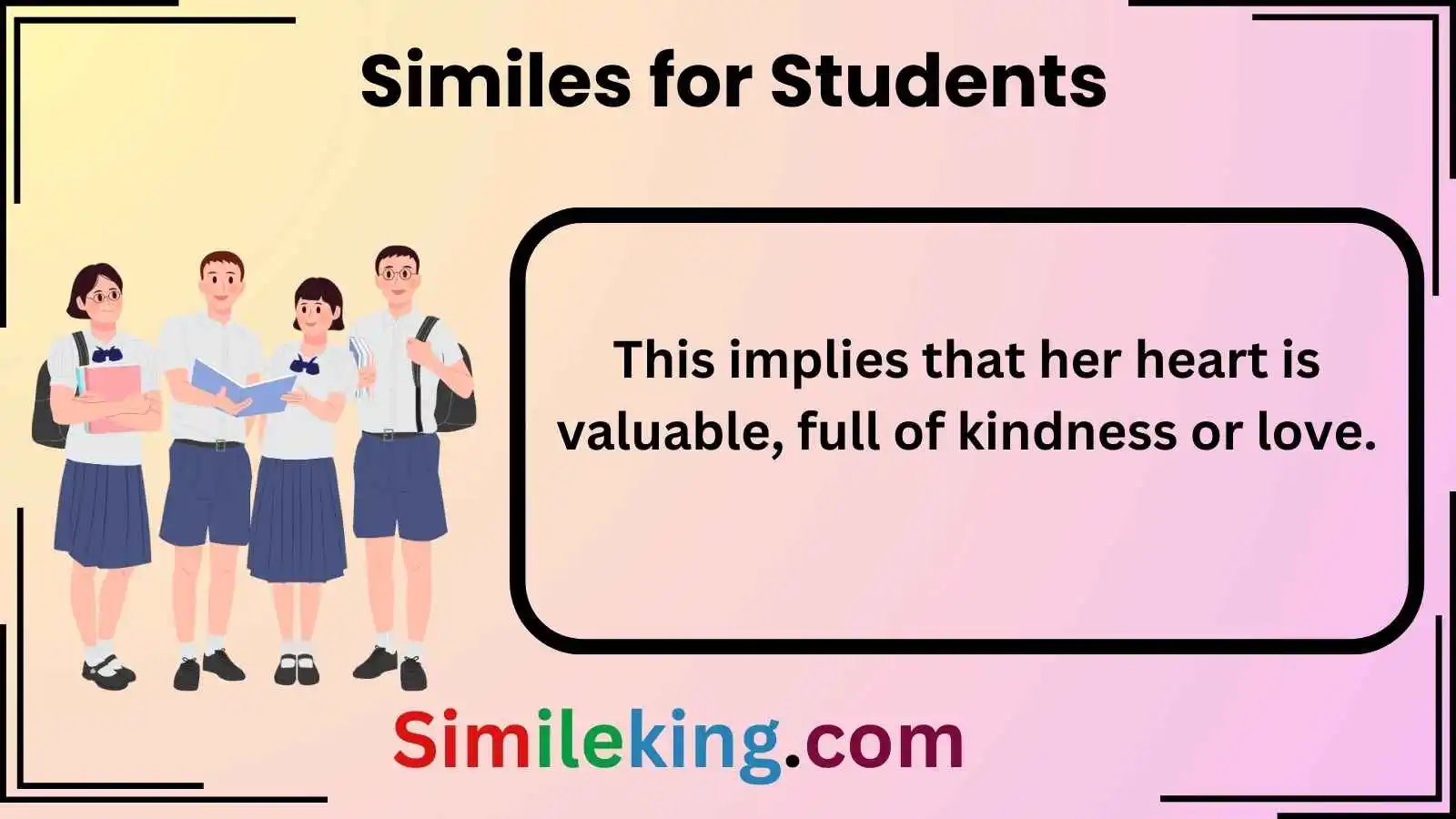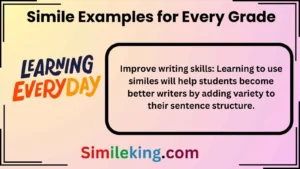Metaphors and similes are two essential tools in figurative language that help make writing more vivid and expressive.
By comparing one thing to another, these figures of speech create more impactful imagery and enhance the reader’s understanding.
Although similar in nature, metaphors and similes serve different purposes in the way they compare ideas or objects.
What Is a Metaphor?
A metaphor directly compares two unrelated things by stating that one thing is another. It suggests a deeper connection between the items, enhancing meaning without using “like” or “as.”
Example of a Metaphor:
- “Time is a thief.” This suggests that time steals moments away, much like a thief steals possessions.
What Is a Simile?
A simile also compares two things, but it uses “like” or “as” to highlight the similarities between them. Similes are often easier for students to understand because they draw more direct comparisons.
Example of a Simile:
- “Her smile was as bright as the sun.” This comparison shows the radiance of the smile by likening it to the sun.
Understanding the difference between metaphors and similes will help students select the right figurative language for their work, whether they are writing essays, poems, or even sending casual texts.
In this article, we’ll explore over 25 examples of both metaphors and similes to help students build their vocabulary and writing skills. Plus, we’ll give you 11 texting examples that are easy to use and Google-friendly for everyday conversations.
25+ Examples of Metaphors and Similes for Students
Here’s a categorized collection of metaphors and similes, perfect for students looking to enhance their writing or communication. We’ll break them into specific categories, such as positive metaphors and similes, negative metaphors and similes, and descriptive metaphors and similes to give students a variety of options.
Positive Metaphors and Similes
These metaphors and similes can be used to express positive attributes or sentiments in a creative way.
- Metaphor:
“Her heart is a goldmine.”
This implies that her heart is valuable, full of kindness or love. - Simile:
“He is as strong as an ox.”
Comparing someone’s strength to an ox suggests great physical strength. - Metaphor:
“The classroom was a jungle.”
This metaphor highlights the chaos or the liveliness of the classroom. - Simile:
“Her voice was as sweet as honey.”
This simile suggests that her voice was pleasant and soothing. - Metaphor:
“The stars are diamonds in the night sky.”
Here, stars are compared to diamonds to emphasize their brilliance and beauty. - Simile:
“The rain fell like tears from the sky.”
This simile makes the rain seem emotional and dramatic.
Negative Metaphors and Similes
These figurative language examples convey negative attributes or emphasize difficult situations.
- Metaphor:
“His mind is a maze.”
This suggests that his thoughts are complicated and difficult to understand. - Simile:
“She was as cold as ice.”
The simile compares someone’s emotional distance to ice, indicating a lack of warmth or affection. - Metaphor:
“The task was a mountain to climb.”
This metaphor implies that the task was very difficult, like a physically challenging mountain. - Simile:
“He was as lost as a needle in a haystack.”
This suggests that the person is extremely lost or confused. - Metaphor:
“The storm inside her was uncontainable.”
This implies that her emotions were overwhelming, like a storm. - Simile:
“Her patience was as thin as paper.”
This indicates that she had very little patience or tolerance.
Descriptive Metaphors and Similes
These metaphors and similes are perfect for painting a detailed picture in the reader’s mind.
- Metaphor:
“The wind was a symphony of whispers.”
This metaphor evokes the idea that the wind sounds like a musical piece made up of soft whispers. - Simile:
“The room was as quiet as a mouse.”
This simile compares the silence of the room to the soft, quiet movement of a mouse. - Metaphor:
“Her eyes were the ocean, deep and endless.”
This metaphor suggests that her eyes were not only beautiful but mysterious and profound. - Simile:
“The leaves danced like flames in the wind.”
This simile compares the movement of the leaves to flames, showing their fluidity and motion. - Metaphor:
“The city was a melting pot of cultures.”
This metaphor suggests that the city contained a diverse mixture of people and cultures. - Simile:
“The mountain was as tall as the clouds.”
This simile compares the towering height of a mountain to the vastness of clouds in the sky.
Nature-Themed Metaphors and Similes
These examples are perfect for connecting the elements of nature with human experience.
- Metaphor:
“The garden is a canvas.”
This metaphor implies that the garden is a work of art, open to creativity and beauty. - Simile:
“The river was like a mirror.”
This compares the smooth surface of a river to a mirror, reflecting everything around it. - Metaphor:
“The tree was a giant, standing tall against the storm.”
This metaphor compares the tree to a giant, emphasizing its strength and endurance. - Simile:
“The clouds were as fluffy as cotton candy.”
This simile uses the softness of cotton candy to describe the clouds in the sky. - Metaphor:
“The rain was a curtain, blocking the view.”
This metaphor suggests that the rain obscured everything, just like a curtain does.
Emotional Metaphors and Similes
These examples highlight the connection between emotions and figurative language.
- Metaphor:
“Her laugh is a melody.”
This metaphor suggests that her laughter is musical and pleasant to hear. - Simile:
“His words were like daggers.”
This simile suggests that his words were harsh and hurtful. - Metaphor:
“The pain was a heavy weight on his shoulders.”
This metaphor emphasizes the emotional burden of pain. - Simile:
“Her sadness was as deep as the ocean.”
This simile compares sadness to the vastness of the ocean, suggesting it’s overwhelming.
11 User-Friendly Texting Examples
When texting, you might want to use metaphors and similes that are simple yet impactful. Here are 11 texting examples that are optimized for clarity and Google-friendly:
- “Your words are like sunshine on a cloudy day.”
- “You’re as rare as a unicorn.”
- “That idea is a lightbulb moment.”
- “You’re as sweet as sugar.”
- “This place is like a maze!”
- “That meeting was like watching paint dry.”
- “She’s like a breath of fresh air.”
- “I’m feeling like a fish out of water right now.”
- “You’re a star in my sky.”
- “He’s like a walking encyclopedia!”
- “That’s a mountain I’m ready to climb.”
These texting examples are user-friendly and work well in everyday conversations, whether you’re talking to friends, colleagues, or even family.
Conclusion
Metaphors and similes are powerful literary tools that bring your writing to life. By using comparisons, you can convey emotions, create vivid imagery, and enrich your communication. Whether you’re writing a formal essay, a poem, or just texting a friend, knowing when and how to use these figures of speech can make your words much more impactful.
Explore the various examples provided in this article and practice incorporating them into your own writing. By understanding the nuances of tone and context, you’ll become a master at using metaphors and similes in any situation.





